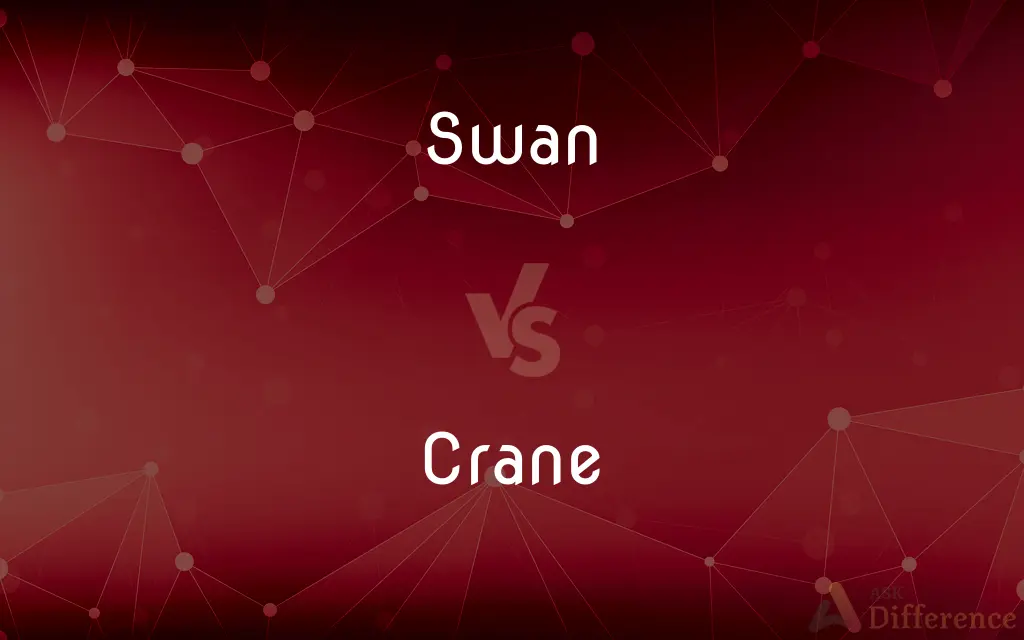Swan vs. Crane — What's the Difference?
By Maham Liaqat & Urooj Arif — Updated on April 4, 2024
Swans are large, graceful aquatic birds with white feathers, linked to romance and mythology. Cranes are tall, slender, with long necks/legs and varied plumage, symbolizing longevity and fidelity.

Difference Between Swan and Crane
Table of Contents
ADVERTISEMENT
Key Differences
Swans are members of the Anatidae family, which also includes ducks and geese. They are characterized by their large size, long curved necks, and predominantly white feathers, with some species displaying black plumage. Cranes, belonging to the family Gruidae, are notable for their tall stature, long legs, and necks, but unlike swans, they exhibit a wider range of colors in their plumage. They are more diverse in habitat, found in wetlands, grasslands, and even arid regions across the globe.
Swans are often found in temperate environments near lakes and ponds, where they glide on the water with elegance, symbolizing purity and beauty in various cultures. Cranes are celebrated for their elaborate mating dances and are revered in many Asian cultures as symbols of happiness and eternal youth.
Swans are mostly sedentary, forming monogamous pairs that mate for life, reflecting themes of loyalty and partnership. Their nests are large and located near water. Conversely, cranes are migratory birds, known for their long-distance flights. They too form lasting bonds with their mates and engage in synchronized dancing as part of their courtship rituals.
Swans are powerful in flight, though they require a running start to take off due to their size and weight. Unlike swans, cranes can launch into flight directly from a standing position, thanks to their lighter body structure and long wings.
Comparison Chart
Family
Anatidae (ducks, geese)
Gruidae
ADVERTISEMENT
Habitat
Temperate lakes and ponds
Wetlands, grasslands, arid regions
Behavior
Sedentary, mate for life
Migratory, elaborate mating dances
Flight
Requires running start
Direct flight from standing
Diet
Aquatic vegetation, small fish, insects
Seeds, plants, insects, small animals
Symbolism
Purity, beauty, love
Longevity, happiness, fidelity
Neck Shape
Long and curved
Long and straight
Compare with Definitions
Swan
Symbol of purity in many cultures.
Swans are often used in literature to symbolize true love.
Crane
A tall bird with a long neck and legs, known for its diverse plumage.
The crane danced elegantly in the wetlands.
Swan
A large aquatic bird with a long neck and white feathers.
The swan gracefully glided across the lake.
Crane
Diet varies widely depending on habitat.
The crane foraged for seeds and insects in the grass.
Swan
Known for their loyalty and monogamous relationships.
Swans mate for life, reflecting themes of fidelity.
Crane
Migratory, traveling long distances annually.
Cranes are famous for their long migratory flights.
Swan
Found in temperate regions around the world.
The lake was home to a family of swans.
Crane
Engages in elaborate mating dances.
The pair of cranes performed a synchronized dance.
Swan
Capable of aggressive behavior when threatened.
Swans can be protective of their young and territory.
Crane
Symbolizes longevity and fidelity in many cultures.
Cranes are revered in Asian art and mythology.
Swan
Swans are birds of the family Anatidae within the genus Cygnus. The swans' closest relatives include the geese and ducks.
Crane
The American blue heron (Ardea herodias).
Swan
A large waterbird with a long flexible neck, short legs, webbed feet, a broad bill, and typically all-white plumage.
Crane
Any of various large wading birds of the family Gruidae, having a long neck, long legs, and a long bill.
Swan
Move about or go somewhere in a casual, irresponsible, or ostentatious way
Swanning around Europe nowadays are we?
Crane
A similar bird, such as a heron.
Swan
Any of various large waterbirds of the genera Cygnus and Coscoroba of the family Anatidae, having webbed feet, a long slender neck, and usually white plumage.
Crane
A machine for hoisting and moving heavy objects by means of cables attached to a movable boom.
Swan
Swan See Cygnus.
Crane
Any of various devices with a swinging arm, as in a fireplace for suspending a pot.
Swan
To travel around from place to place
"Swanning around Europe nowadays, are we?" (Jeffrey Archer).
Crane
To hoist or move with or as if with a crane.
Swan
To declare; swear. Used in the phrase I swan as an interjection. See Note at vum.
Crane
To strain and stretch (the neck, for example) in order to see better.
Swan
Any of various species of large, long-necked waterfowl, of genus Cygnus (bird family: Anatidae), most of which have white plumage.
Crane
To stretch one's neck toward something for a better view.
Swan
(figuratively) One whose grace etc. suggests a swan.
Crane
To be irresolute; hesitate.
Swan
(heraldry) This bird used as a heraldic charge, sometimes with a crown around its neck (e. g. the arms of Buckinghamshire).
Crane
Any bird of the family Gruidae, large birds with long legs and a long neck which is extended during flight.
Swan
(intransitive) To travel or move about in an aimless, idle, or pretentiously casual way.
Crane
Ardea herodias, the great blue heron.
Swan
To declare (chiefly in first-person present constructions).
Crane
A mechanical lifting machine or device, often used for lifting heavy loads for industrial or construction purposes.
Swan
Fig.: An appellation for a sweet singer, or a poet noted for grace and melody; as Shakespeare is called the swan of Avon.
Crane
An iron arm with horizontal motion, attached to the side or back of a fireplace for supporting kettles etc. over the fire.
Swan
The constellation Cygnus.
Crane
A siphon, or bent pipe, for drawing liquors out of a cask.
Swan
To declare or affirm solemnly and formally as true;
Before God I swear I am innocent
Crane
(nautical) A forked post or projecting bracket to support spars, etc.; generally used in pairs.
Swan
Move about aimlessly or without any destination, often in search of food or employment;
The gypsies roamed the woods
Roving vagabonds
The wandering Jew
The cattle roam across the prairie
The laborers drift from one town to the next
They rolled from town to town
Crane
(obsolete) The cranium.
Swan
Sweep majestically;
Airplanes were swanning over the mountains
Crane
(ambitransitive) To extend (one's neck).
Crane
(transitive) To raise or lower with, or as if with, a crane.
Crane
(intransitive) To pull up before a jump.
Crane
A wading bird of the genus Grus, and allied genera, of various species, having a long, straight bill, and long legs and neck.
Crane
Any arm which swings about a vertical axis at one end, used for supporting a suspended weight.
Crane
A machine for raising and lowering heavy weights, and, while holding them suspended, transporting them through a limited lateral distance. In one form it consists of a projecting arm or jib of timber or iron, a rotating post or base, and the necessary tackle, windlass, etc.; - so called from a fancied similarity between its arm and the neck of a crane See Illust. of Derrick.
Crane
An iron arm with horizontal motion, attached to the side or back of a fireplace, for supporting kettles, etc., over a fire.
Crane
A siphon, or bent pipe, for drawing liquors out of a cask.
Crane
A forked post or projecting bracket to support spars, etc., - generally used in pairs. See Crotch, 2.
Crane
To cause to rise; to raise or lift, as by a crane; - with up.
What engines, what instruments are used in craning up a soul, sunk below the center, to the highest heavens.
An upstart craned up to the height he has.
Crane
To stretch, as a crane stretches its neck; as, to crane the neck disdainfully.
Crane
To reach forward with head and neck, in order to see better; as, a hunter cranes forward before taking a leap.
The passengers eagerly craning forward over the bulwarks.
Crane
United States writer (1871-1900)
Crane
United States poet (1899-1932)
Crane
Lifts and moves heavy objects; lifting tackle is suspended from a pivoted boom that rotates around a vertical axis
Crane
Large long-necked wading bird of marshes and plains in many parts of the world
Crane
Stretch (the neck) so as to see better;
The women craned their necks to see the President drive by
Common Curiosities
How can you distinguish a swan from a crane?
Look at their body shape, habitat, and behavior; swans have a more curved neck and are usually found in water, while cranes have straighter necks, longer legs, and are often seen in various terrestrial habitats.
Do swans and cranes interact in the wild?
They might share habitats but generally do not interact closely due to their different lifestyles and dietary needs.
Are swans aggressive?
Swans can be aggressive, especially during breeding season or when protecting their young.
Can both swans and cranes fly?
Yes, both can fly, but swans require a running start to take off because of their heavier bodies, while cranes can take off directly from standing.
Why do cranes dance?
Cranes perform elaborate dances as part of their courtship rituals to strengthen bonds with their mates and deter rivals.
What do swans eat?
Swans mostly eat aquatic vegetation, but they can also consume small fish and insects.
Where can you find cranes?
Cranes can be found across all continents except South America and Antarctica, in a variety of habitats from wetlands to grasslands.
Can cranes be found in urban areas?
While cranes prefer natural wetlands, some species can adapt to urban environments if suitable wetlands are available.
How long do swans and cranes live?
Both can live for several decades in the wild, with life spans varying by species. Cranes are among the birds with the longest lifespans.
What is the significance of cranes in Asian cultures?
Cranes are symbolic of happiness, eternal youth, and marital fidelity in many Asian traditions.
Why are swans associated with romance?
The elegance, monogamous nature, and often pure white plumage of swans have made them symbols of love and fidelity.
Are all swans white?
Most swan species are white, but there are black and mixed-colored species, such as the black swan and the black-necked swan.
What role do swans and cranes play in ecosystems?
Both play significant roles in their ecosystems, including controlling insect populations and contributing to the health of aquatic and terrestrial habitats.
How are cranes protected in the wild?
Many crane species are protected under international agreements and conservation programs due to their habitat requirements and migratory patterns.
Do swans migrate?
Some swan species migrate short distances, but many are sedentary, staying near their preferred aquatic habitats year-round.
Share Your Discovery

Previous Comparison
Pine vs. Turpentine
Next Comparison
Respected vs. ValuedAuthor Spotlight
Written by
Maham LiaqatCo-written by
Urooj ArifUrooj is a skilled content writer at Ask Difference, known for her exceptional ability to simplify complex topics into engaging and informative content. With a passion for research and a flair for clear, concise writing, she consistently delivers articles that resonate with our diverse audience.














































